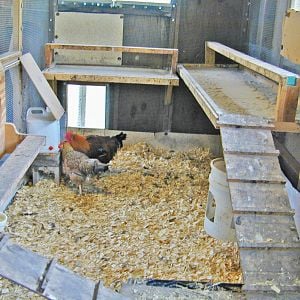My first rule on laying out a chicken coop is to make it convenient for you. If it is comfortable for you to take care of your chickens you will do a better job of it, enjoy it more, and your chickens will reap the benefits.
Vertically first determine the height of the floor after you put bedding in. Your pop door needs to be high enough so bedding doesn't get scratched out. Then position your nests. Some people like the nests down low, maybe to the point of a milk crate sitting on the coop floor. Others like them high enough they don't have bend over to gather eggs. Bad backs are no fun. Many of us have our personal preferences but it should be what is comfortable and convenient for you, not what I like.
Then put your roosts noticeably higher than the nests. Chickens tend to sleep in the highest spots available. If your roosts are higher than your nests that generally means they do not sleep in your nests and poop there. But try to keep the roosts as low as you reasonably can. In a coop your size this should not be a big problem for you, but the higher the roosts the larger clear landing area they need. You don't want them bumping into feeders, waterers, nests, or walls on the way down.
In the summer a nice warm breeze hitting the chickens on the roosts is comfortable to them. But you are in Ontario. Thanks for providing that info, it helps in a few ways. In winter you will get cold winds, which is bad if they hit the birds. Even in winter you need decent ventilation. My personal preference is to have winter ventilation over their heads when they are on the roosts so any breezes are over their heads. Make sure they put those gable vents as high as reasonable in those peaks. I don't know if that will be enough or not. Since you have overhangs an easy way to provide a lot more ventilation but keep rain and snow out is to leave the top few inches of your side walls open and cover that with hardware cloth against predators. Often the framing up there makes construction easier if you do that. Another option might be soffit vents but those might be more expensive and, depending on how they are screened, maybe vulnerable for predators. You could put a ridge vent up top. That will help in summer but might get blocked by snow in winter.
The door shown opens out so you don't have to worry about bedding building up high enough to block it or keeping the swing open. You still need to be able to step through when you are carrying something so keep that area clear inside.
There are lots of different ways you could lay that out inside. Typically your roosts are a height that you can bump into so you want them on a wall that won't restrict your entering or walking around, especially when gathering eggs or feeding or watering. You don't want to trip over waterers or feeders. It's hard for me to come up with just one "best' layout because there are so many different ones that can work perfectly well.
By saying you might put a brooder in there you imply ten is not the final number you are planning on. Don't plan your coop for ten hens. Plan for the final number you expect. Three nests is plenty for ten hens. Will you need more later? How much roost will you eventually need? Keep in mind that if you integrate you need a lot more room than you need for them after they are integrated. That's not just floor space, that's also roost space.
When you build a coop things never go exactly as you plan. You practically always go back and change or add something. Having extra space gives you the flexibility to address that. This has nothing to do with coop layout, but don't crowd them to the point that you lose all flexibility.
Rosemary mentioned that things can go under dropping boards. Sometime visuals can help or maybe in this case scare you away. I built in a brooder under my roosts and used the top of the brooder as a drippings board.
Then a really scary one, my nests. You can see my brooder off to the right. I started out with the two bottom ones but realized when I kept pullets instead of just my hens that I needed more. That area between the two bottom nests is where I could isolate a chicken if I needed to. That's a waste, I've hardly ever used it. But I thought it was a good idea at the time.
When I started integrating younger chickens I realized I need a juvenile roost to stop them from sleeping in my nests. It's noticeably higher than the nests so that is where they sleep. The top of the nests are my droppings boards It's a horrible design, it would look a lot different if I'd known all this when I started. But maybe this will illustrate what I mean when I say sometimes you have to change things.




